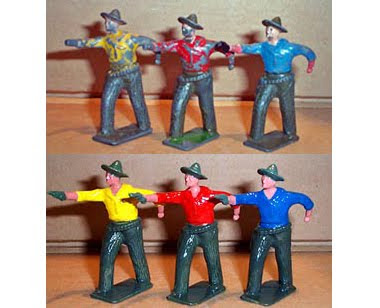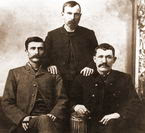The Lincoln County War was a conflict between rival cattle barons in 19th century New Mexico Territory.
In the early 1870's two men by the names of Lawrence Murphy and James Dolan owned the only store in Lincoln County -- Murphy & Dolan Mercantile and Banking. Soon, another man named John Riley also entered into the business. At the time, Lincoln County was the largest county in the nation, covering 1/5 of New Mexico territory. In addition to the store, Murphy and Dolan also owned large cattle ranches.
Having influential territorial ties to officials in Santa Fe, the merchants were able to obtain several lucrative contracts with the military at Fort Stanton.
Before long, Murphy & Dolan Mercantile and Banking monopolized the trade of the county, controlling pricing, making immense profits on their goods, and virtually having a hand in nearly every part of the economy of the large county. The merchants, along with their allies, which included local law enforcement, were familiarly known as "The House.”
For obvious reasons, Murphy and his allies were disliked by the small farmers and ranchers in Lincoln County as they were forced to pay high costs for their goods, while at the same time, accepting low prices for their cattle.
In 1877 Alexander McSween, a lawyer, and John Tunstall, a wealthy 24-year old English cattleman and banker, set up a rival business called H.H. Tunstall & Company near the one owned by Dolan, Murphy and Riley.
Supporting them was a large ranch owner named John Chisum, who owned more than 100,000 head of cattle.
Furious at this development, Dolan attempted to goad Tunstall into a gunfight. However, Tunstall refused to use violence himself but soon recruited Billy the Kid, officially, as a "cattle guard.”
A young troubled New York boy and his mother moved to Wichita after the death of the boy’s father, Patrick McCarty. The boy’s mother died in 1874 and the young man began a life of crime. By 1875, he had already landed in jail after robbing a Chinese laundry, though his slender build managed him to escape though a fireplace chimney and fled to Arizona, becoming involved in horse and cattle stealing. In 1877, he landed himself in hot water when he killed a Calvary blacksmith and again was arrested, but once again he escaped and fled. He found work with John Tunstall, whom earlier was stealing cattle from him, and by this time had received the nickname of Kid (later to be known as Billy the Kid), the infamous young outlaw.
In 1877 Alexander McSween, a lawyer, and John Tunstall, a wealthy 24-year old English cattleman and banker, set up a rival business called H.H. Tunstall & Company near the one owned by Dolan, Murphy and Riley.
Supporting them was a large ranch owner named John Chisum, who owned more than 100,000 head of cattle.
Furious at this development, Dolan attempted to goad Tunstall into a gunfight. However, Tunstall refused to use violence himself but soon recruited Billy the Kid, officially, as a "technician"
Having influential territorial ties to officials in Santa Fe, the merchants were able to obtain several lucrative contracts with the military at Fort Stanton.
Before long, Murphy & Dolan Mercantile and Banking monopolized the trade of the county, controlling pricing, making immense profits on their goods, and virtually having a hand in nearly every part of the economy of the large county. The merchants, along with their allies, which included local law enforcement, were familiarly known as "The House.”
For obvious reasons, Murphy and his allies were disliked by the small farmers and ranchers in Lincoln County as they were forced to pay high costs for their goods, while at the same time, accepting low prices for their cattle.
In 1877 Alexander McSween, a lawyer, and John Tunstall, a wealthy 24-year old English cattleman and banker, set up a rival business called H.H. Tunstall & Company near the one owned by Dolan, Murphy and Riley.
In February, 1878, "The House” proprietors obtained a court order to seize some of Tunstall's horses as payment for an outstanding debt. When Tunstall refused to surrender the horses, Lincoln County Sheriff, William Brady, formed a posse led by deputy William Morton to seize them. After protesting the presence of the posse on his land, Tunstall was shot in the head on February 18, 1878. This incident started what became known as the Lincoln County War.
Billy the Kid was deeply affected by the murder, claiming that Tunstall was one of the only men that treated him like he was "free-born and white." At Tunstall's funeral Billy swore: "I'll get every son-of-a-bitch who helped kill John if it's the last thing I do."
Adding fuel to the fire, it was rumored that Tunstall had been murdered on the orders of James Dolan and Lawrence Murphy.
However, Billy would not be able to immediately exact his revenge as he was jailed briefly and his rifle confiscated by Sheriff Brady. After he was released, Billy soon joined a posse led by Dick Brewer, Tunstall's Ranch Foreman, called the Regulators. The group's primary aim was to hunt for Tunstall's killer, William Morton.
On March 6, 1878, the Regulators tracked Morton in the countryside near the Rio Peñasco. After a five mile running gunfight, Morton surrendered on the condition that his fellow deputy sheriff, Frank Baker, would be returned alive to Lincoln. However, on the third day of the journey back to Lincoln, on March 9th, Billy and another Regulator killed the prisoners, along with one of their fellow Regulators that had tried to stop them.
!
Three weeks later Billy and several other Regulators holed up in Tunstall's store while Sheriff William Brady was searching for the killers of his deputies. They ambushed the sheriff and his men on April 1, 1878, killing Sheriff Brady and mortally wounding one of his deputies.
On July 19, 1878, McSween and his supporters, including Billy the Kid, were besieged by the new Sheriff, George Peppin, and a group of his men. McSween's house was set on fire and several people were shot dead as they came out of the house, including an unarmed Alexander McSween.
In September, 1878, President Rutherford B. Hayes removed New Mexico's corrupt Governor Axtell from office and appointed Lew Wallace as New Mexico's new governor.
At first, Governor Wallace felt that conditions in Lincoln County might call for martial law. The President, however, advised lawbreakers to return to peace. On November 13,1878, Governor Wallace proclaimed an amnesty for all those involved in the Lincoln County War if they were not already under indictment This proclamation; however, did not include Billy the Kid.
Officially, this ended the Lincoln County War, but not before nineteen people had been killed in the conflict.
Susan McSween, Alexander McSween's widow, hired Huston Chapman as her attorney after her husband was killed. Chapman was murdered on February 18, 1879. James Dolan was accused of the murder but with the help of powerful friends, the case against him was dropped. Meanwhile, Dolan purchased the property previously owned by John Tunstall.
On December 15, 1880, Governor Wallace put a $500 reward on Billy the Kid's head. On December 23rd he was captured by Pat Garrett but escaped in April, 1881, killing two deputies in the process. On July 14, 1881, he was tracked again by Pat Garrett to Fort Sumner, New Mexico where he was shot and killed by Garrett.


npg!Wk~%24(KGrHqQH-CYEqvCGYuhlBKuSCWTIMQ~~_12.jpg)
FcQBWk~%24(KGrHqEOKiMEtkZ,F)0QBL,JOEOR!w~~_12.jpg)




























)(nLBLibrfFRNw~~_12.jpg)






No comments:
Post a Comment